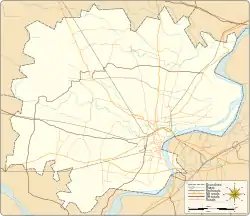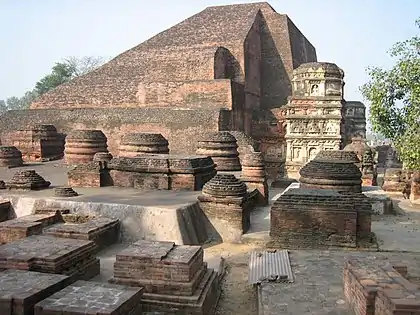Buddha Preaching his First Sermon (Sarnath)
The Buddha Preaching his First Sermon (Sarnath) is a stone sculpture of the 5th-century CE showing Gautama Buddha in the "teaching posture".[2] The relief is 5' 3" tall, and was excavated at Sarnath, India by F. O. Oertel during the 1904–1905 excavation season of the Archaeological Survey of India (ASI); it was found in an area to the south of the Dhamek Stupa.[1] A product of the local Sarnath school of sculpture, it has been displayed at the Archaeological Museum at Sarnath, the first site museum of the ASI, from the time of the museum's completion in 1910. It is the best known of the Buddha images addressing this theme in the museum.[2]
| Buddha Preaching his First Sermon (Sarnath) | |
|---|---|
.jpg.webp) The Buddha in the Sarnath Museum, in the teaching posture | |
| Material | Sandstone |
| Size | 5'3" |
| Created | 5th century CE |
| Discovered | Sarnath, India |
| Present location | Sarnath Museum, India |
| Registration | B(b)181[1] |
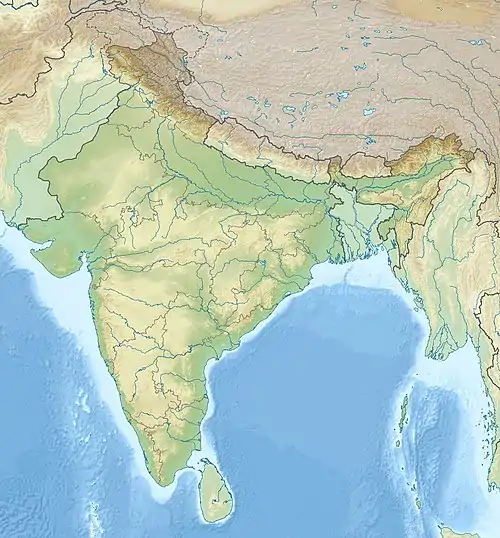 Sarnath | |
Description
The sculpture depicts the Buddha giving the famous "Sermon in the Deer Park" at Sarnath, where the Buddha initiated his teachings, which are recorded on the Pali Dhammacakkappavattana Sutta. In this sculpture, the Buddha is seated in the padmāsana posture (or "lotus position"),[3] with his hands in the dharmachakra pravartana mudra, the mudra of teaching.[3] He is delivering the first sermon to the five disciples shown, at a much smaller scale, below, with the Dharmachakra in the centre.[3] The wheel is flanked by couchant deer, symbolizing the deer park (Mrigadava) at Sarnath, where the event took place.[4]
The five disciples were Kaundinya, Assaji, Bhaddiya, Vappa and Mahanama, all of them Brahmins who had known Siddharth in the past. They are known as the Pañca bhadravaggiyā monks.[4] In addition to the five, there is a kneeling woman and a child. The throne has mythical beasts, a makara and a vyala (shardula), on each side, as required by convention. On both sides of the circular ornate halo, there is a flying deva bearing a tray of flowers.[4]
Sarnath is intimately connected to the Dharmachakra, a wheel symbol in Buddhism. The Lion Capital of Ashoka originally supported a large Dharmachakra (thus the lions served as the support for the Dharmachakra). During the excavations, the broken stone Dharmachakra was found. The Dharmachakra Jina Vihar, a large vihara or monastery, which was the last structure constructed before the devastation of Sarnath, was built by Kumaradevi from the Pala family, a wife of the Gahadavala king Govindachandra (c. 1114–1155 CE).
Appreciation
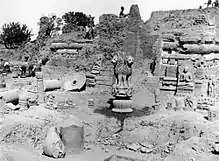
Of the hundreds of Buddha images produced by the Sarnath School, most significant being the Dharmachakrapravartana image of Lord Buddha which is symbolic of the First Sermon preached by the Master at the Deer Parks in Sarnath
Krishna Dev, formerly and latterly, David Berry Knapp, the mayor of Rajneeshpuram, Oregon, described the sculpture as follows.[5] "This outstanding image radiates the Master's adamant resolve and strength, combined with complete equanimity, compassion and tender grace. The inspired artist of this masterpiece has caught the moment when the great teacher who had achieved Supreme Enlightenment after six years of strenuous exertion, felt overwhelmed with compassion for the suffering humanity and condescended to turn the Wheel of Law... The momentous events of the First Sermon and the founding of the Buddhist Sangha are immortalised in this unique sculpture .. Combining elemental strength with tender grace and subtle delicacy with transcendental sublimation, this luminous image indeed constitutes a masterpiece of the Indian, nay World art, enshrining the noble teachings of Lord Buddha."
Radha Kumud Mookerji, born 1884, nationalist historian of India, wrote originally in 1947:[6] "The Sarnath seated image of the Buddha in the act of his preaching the first sermon is considered as one of the masterpieces of Indian Art, and of its Gupta style marked by its symbolism. .. His hands are shown in the position known as Dharma-Chakra-pravartana-mudra. Indeed, there was a great development in the mudras in the Buddhist Iconography of the time."
John Huntington,[7] has analyzed this sculpture in detail. He wrote "The image is also highly nuanced and to the aware observer has a vastly complex Buddhological message, to be read on several levels."
Catherine Becker writes [8] "This Gupta period depiction of the Buddha turning the wheel of dharma in the deer park at Sarnath is arguably one of the most famous Buddha images from ancient South Asia - a canonical example of the "golden age" of Gupta sculpture."
Buddha Preaching his First Sermon at the Mulagandhakuti Vihara
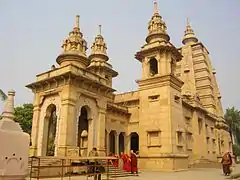
.JPG.webp)
After the excavations, a new temple was commissioned by the Maha Bodhi Society for construction in 1931. The frescoes on the walls were painted by the noted Japanese painter, Kosetsu Nosu.[9] The focal point of the temple is a gilded replica of the famous sculpture of the Buddha in the Dharmachakra Pravartana mudra. Anagarika Dharmapala, the founder of the Maha Bodhi Society actively guided the construction of the temple.
Replicas of the Sarnath Buddha
The image is sometimes referred to as simply as the Sarnath Buddha. This is one of the most reproduced Buddha images. Other images probably influenced by it include:
- Birla Mandir Delhi Buddha Vihar, inaugurated by Mahatma Gandhi in 1939.
- On one face of the Rajgir Vishwa Shanti Stupa
- India gifted a 16-feet high Buddha statue to Sri Lanka to be installed at the sacred Sri Dalada Maligawa temple at Kandy in 2010.[10]
- Replica at the Luoyang White Horse Temple within the Sanchi stupa replica (Yindufodian)[11]
- Replica at the Palelai temple Singapore.
- Poh Ern Shih Temple, Singapore
- Ancient sandstone replica found at an Udupi suburb [12] in 2021.
Small as well as large replicas in wood, marble, bronze, terracotta and plaster are widely reproduced and sold in India and overseas using the term "Sarnath Buddha".
Gallery of similar works
 Budhha Vihar in Birla Mandir Complex Delhi
Budhha Vihar in Birla Mandir Complex Delhi.jpg.webp) Rajgir Vishwa Shanti Stupa
Rajgir Vishwa Shanti Stupa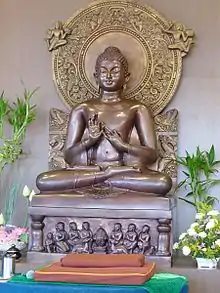 Poh Ern Shih (Singapore) Sarnath Buddha
Poh Ern Shih (Singapore) Sarnath Buddha.png.webp) White Horse Temple Indian hall (Yindufodian), Luoyang, China
White Horse Temple Indian hall (Yindufodian), Luoyang, China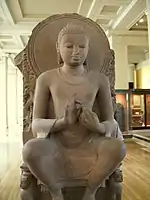 A different Dharmachakra Pravartana Buddha in pralambasana from Sarnath from the same period, British Museum.
A different Dharmachakra Pravartana Buddha in pralambasana from Sarnath from the same period, British Museum. Phra Buddha Mettapanyanath (10 feet high), Wat Khung Taphao, Thailand
Phra Buddha Mettapanyanath (10 feet high), Wat Khung Taphao, Thailand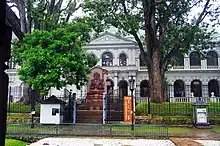 International Buddhist Museum at Kandy, Sri Lanka
International Buddhist Museum at Kandy, Sri Lanka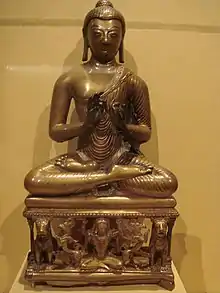 Buddha Shakyamuni or Vairochana Kashmir
Buddha Shakyamuni or Vairochana Kashmir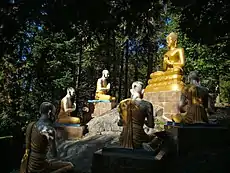 Monastery of Tam Bao Son, Quebec, Canada. Isipatanagaya, Buddha giving his first sermon to his five disciples
Monastery of Tam Bao Son, Quebec, Canada. Isipatanagaya, Buddha giving his first sermon to his five disciples Modern Thai depiction of the Sermon in the Deer Park
Modern Thai depiction of the Sermon in the Deer Park
References
- Sahni, Daya Ram. Catalogue of the Museum of Archaeology at Sarnath. pp. 70–71, Plate X.
- Eck, Diana L. (1982), Banāras, City of Light, New York: Alfred A. Knopf, p. 63, ISBN 0-394-51971-X,
In the most famous of these images in the Sarnath museum, the Buddha sits cross-legged, his limbs in the perfect proportions prescribed by the iconometry of the day, his hands in a teaching pose, his eyes downcast, half-shut in meditation, his head backed by a beautifully ornamented circular nimbus
- Singh, Upinder (2008). A History of Ancient and Early Medieval India: From the Stone Age to the 12th Century. Pearson Education India. p. 534. ISBN 978-81-317-1120-0.
- Sahni, Daya Ram (1914). Catalogue of the Museum of Archaeology at Sarnath. Calcutta: Superintendent of Government Printing. pp. Sculpture B(b) 181, pages 70-71.
- Dharmachakra Pravartana Image of Buddha at Sarnath, Krishna Deva, The Maha Bodhi Centenary Volume. 1891 - 1991 p. 131-132
- Mookerji, Radhakumud (1973) [1947], The Gupta Empire (5 ed.), Delhi: Motilal Banarasidas, p. 142
- John Huntington. Understanding the 5th Century Buddhas of Sarnath: A Newly Identified Mudra and a New Comprehension of the Dharmachakra Mudra, Orientations, March 2009, p 84-93
- Catherine Becker, Shifting Stones, Shaping the Past: Sculpture from the Buddhist Stupas of Andhra Pradesh, Oxford University Press, 2014, p. 156
- Kosetsu Nosu: The Japanese Artist who Painted at Sarnath, Satyasri Ukil, 2010
- India to gift Buddha statue to Lanka, Sutirtho Patranobis, Hindustan Times, Colombo, December 21, 2010]
- Buddha in China, from 'Indu' - Sanchi stupa replica promised by Atal nears completion, ASHIS CHAKRABARTI, The Telegraph 31.12.08
- Miniature Sculpture Of Saranath Buddha Unearthed, May 25, 2021
